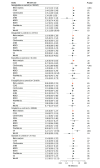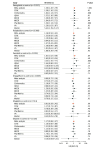Semaglutide and Nonarteritic Anterior Ischemic Optic Neuropathy
- PMID: 39976940
- PMCID: PMC11843465
- DOI: 10.1001/jamaophthalmol.2024.6555
Semaglutide and Nonarteritic Anterior Ischemic Optic Neuropathy
Abstract
Importance: Semaglutide, a glucagonlike peptide-1 receptor agonist (GLP-1RA), has recently been implicated in cases of nonarteritic anterior ischemic optic neuropathy (NAION), raising safety concerns in the treatment of type 2 diabetes (T2D).
Objective: To investigate the potential association between semaglutide and NAION in the Observational Health Data Sciences and Informatics (OHDSI) network.
Design, setting, and participants: This was a retrospective study across 14 databases (6 administrative claims and 8 electronic health records). Included were adults with T2D taking semaglutide, other GLP-1RA (dulaglutide, exenatide), or non-GLP-1RA medications (empagliflozin, sitagliptin, glipizide) from December 1, 2017, to December 31, 2023. The incidence proportion and rate of NAION were calculated. Association between semaglutide and NAION was assessed using 2 approaches: an active-comparator cohort design comparing new users of semaglutide with those taking other GLP-1RAs and non-GLP-1RA drugs, and a self-controlled case-series (SCCS) analysis to compare individuals' risks during exposure and nonexposure periods for each drug. The cohort design used propensity score-adjusted Cox proportional hazards models to estimate hazard ratios (HRs). The SCCS used conditional Poisson regression models to estimate incidence rate ratios (IRRs). Network-wide HR and IRR estimates were generated using a random-effects meta-analysis model.
Exposures: GLP-1RA and non-GLP-1RAs.
Main outcomes and measures: NAION under 2 alternative definitions based on diagnosis codes: one more inclusive and sensitive, the other more restrictive and specific.
Results: The study included 37.1 million individuals with T2D, including 810 390 new semaglutide users. Of the 43 620 new users of semaglutide in the Optum's deidentified Clinformatics Data Mart Database, 24 473 (56%) were aged 50 to 69 years, and 26 699 (61%) were female. The incidence rate of NAION was 14.5 per 100 000 person-years among semaglutide users. The HR for NAION among new users of semaglutide was not different compared with that of the non-GLP-1RAs using the sensitive NAION definition-empagliflozin (HR, 1.44; 95% CI, 0.78-2.68; P = .12), sitagliptin (HR, 1.30; 95% CI, 0.56-3.01; P = .27), and glipizide (HR, 1.23; 95% CI, 0.66-2.28; P = .25). The risk was higher only compared with patients taking empagliflozin (HR, 2.27; 95% CI, 1.16-4.46; P = .02) using the specific definition. SCCS analysis of semaglutide exposure showed an increased risk of NAION (meta-analysis IRR, 1.32; 95% CI, 1.14-1.54; P < .001).
Conclusions and relevance: Results of this study suggest a modest increase in the risk of NAION among individuals with T2D associated with semaglutide use, smaller than that previously reported, and warranting further investigation into the clinical implications of this association.
Conflict of interest statement
Figures




Comment on
-
Semaglutide and Risk of NAION-Additional Insights.JAMA Ophthalmol. 2025 Apr 1;143(4):315-316. doi: 10.1001/jamaophthalmol.2025.0005. JAMA Ophthalmol. 2025. PMID: 39976950 No abstract available.
References
Publication types
MeSH terms
Substances
Grants and funding
LinkOut - more resources
Full Text Sources
Medical

